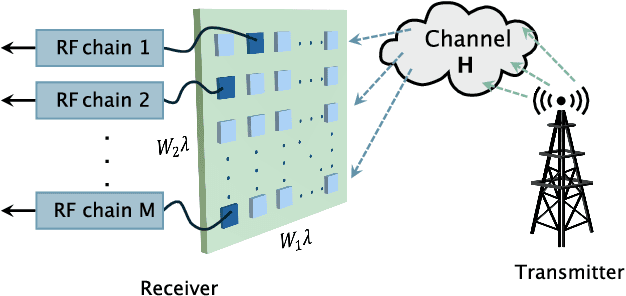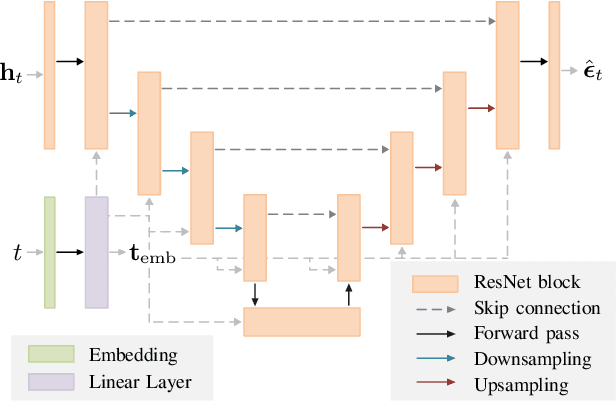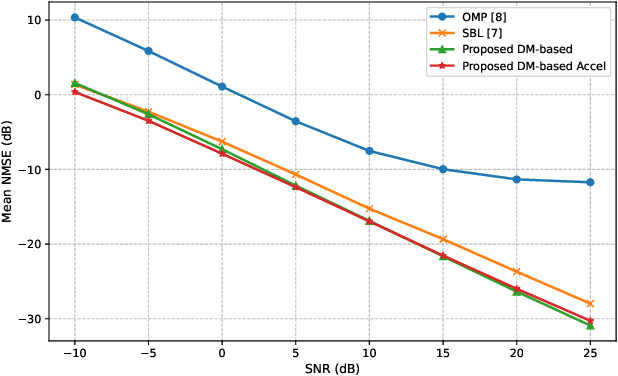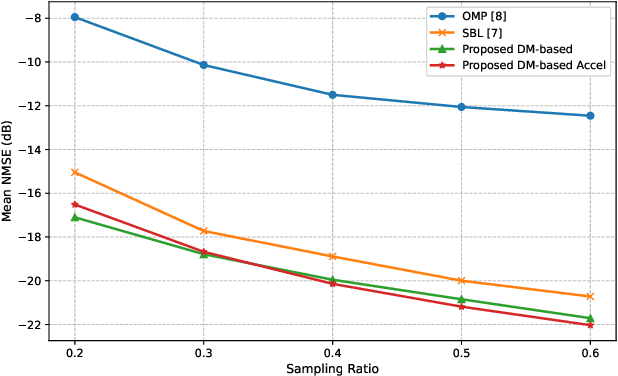Khaled B. Letaief
Sherman
Fluid Antenna-Assisted MU-MIMO Systems with Decentralized Baseband Processing
May 08, 2025Abstract:The fluid antenna system (FAS) has emerged as a disruptive technology, offering unprecedented degrees of freedom (DoF) for wireless communication systems. However, optimizing fluid antenna (FA) positions entails significant computational costs, especially when the number of FAs is large. To address this challenge, we introduce a decentralized baseband processing (DBP) architecture to FAS, which partitions the FA array into clusters and enables parallel processing. Based on the DBP architecture, we formulate a weighted sum rate (WSR) maximization problem through joint beamforming and FA position design for FA-assisted multiuser multiple-input multiple-output (MU-MIMO) systems. To solve the WSR maximization problem, we propose a novel decentralized block coordinate ascent (BCA)-based algorithm that leverages matrix fractional programming (FP) and majorization-minimization (MM) methods. The proposed decentralized algorithm achieves low computational, communication, and storage costs, thus unleashing the potential of the DBP architecture. Simulation results show that our proposed algorithm under the DBP architecture reduces computational time by over 70% compared to centralized architectures with negligible WSR performance loss.
Accurate and Fast Channel Estimation for Fluid Antenna Systems with Diffusion Models
May 08, 2025



Abstract:Fluid antenna systems (FAS) offer enhanced spatial diversity for next-generation wireless systems. However, acquiring accurate channel state information (CSI) remains challenging due to the large number of reconfigurable ports and the limited availability of radio-frequency (RF) chains -- particularly in high-dimensional FAS scenarios. To address this challenge, we propose an efficient posterior sampling-based channel estimator that leverages a diffusion model (DM) with a simplified U-Net architecture to capture the spatial correlation structure of two-dimensional FAS channels. The DM is initially trained offline in an unsupervised way and then applied online as a learned implicit prior to reconstruct CSI from partial observations via posterior sampling through a denoising diffusion restoration model (DDRM). To accelerate the online inference, we introduce a skipped sampling strategy that updates only a subset of latent variables during the sampling process, thereby reducing the computational cost with minimal accuracy degradation. Simulation results demonstrate that the proposed approach achieves significantly higher estimation accuracy and over 20x speedup compared to state-of-the-art compressed sensing-based methods, highlighting its potential for practical deployment in high-dimensional FAS.
Multimodal Deep Learning-Empowered Beam Prediction in Future THz ISAC Systems
May 05, 2025Abstract:Integrated sensing and communication (ISAC) systems operating at terahertz (THz) bands are envisioned to enable both ultra-high data-rate communication and precise environmental awareness for next-generation wireless networks. However, the narrow width of THz beams makes them prone to misalignment and necessitates frequent beam prediction in dynamic environments. Multimodal sensing, which integrates complementary modalities such as camera images, positional data, and radar measurements, has recently emerged as a promising solution for proactive beam prediction. Nevertheless, existing multimodal approaches typically employ static fusion architectures that cannot adjust to varying modality reliability and contributions, thereby degrading predictive performance and robustness. To address this challenge, we propose a novel and efficient multimodal mixture-of-experts (MoE) deep learning framework for proactive beam prediction in THz ISAC systems. The proposed multimodal MoE framework employs multiple modality-specific expert networks to extract representative features from individual sensing modalities, and dynamically fuses them using adaptive weights generated by a gating network according to the instantaneous reliability of each modality. Simulation results in realistic vehicle-to-infrastructure (V2I) scenarios demonstrate that the proposed MoE framework outperforms traditional static fusion methods and unimodal baselines in terms of prediction accuracy and adaptability, highlighting its potential in practical THz ISAC systems with ultra-massive multiple-input multiple-output (MIMO).
Satellite Edge Artificial Intelligence with Large Models: Architectures and Technologies
Apr 02, 2025Abstract:Driven by the growing demand for intelligent remote sensing applications, large artificial intelligence (AI) models pre-trained on large-scale unlabeled datasets and fine-tuned for downstream tasks have significantly improved learning performance for various downstream tasks due to their generalization capabilities. However, many specific downstream tasks, such as extreme weather nowcasting (e.g., downburst and tornado), disaster monitoring, and battlefield surveillance, require real-time data processing. Traditional methods via transferring raw data to ground stations for processing often cause significant issues in terms of latency and trustworthiness. To address these challenges, satellite edge AI provides a paradigm shift from ground-based to on-board data processing by leveraging the integrated communication-and-computation capabilities in space computing power networks (Space-CPN), thereby enhancing the timeliness, effectiveness, and trustworthiness for remote sensing downstream tasks. Moreover, satellite edge large AI model (LAM) involves both the training (i.e., fine-tuning) and inference phases, where a key challenge lies in developing computation task decomposition principles to support scalable LAM deployment in resource-constrained space networks with time-varying topologies. In this article, we first propose a satellite federated fine-tuning architecture to split and deploy the modules of LAM over space and ground networks for efficient LAM fine-tuning. We then introduce a microservice-empowered satellite edge LAM inference architecture that virtualizes LAM components into lightweight microservices tailored for multi-task multimodal inference. Finally, we discuss the future directions for enhancing the efficiency and scalability of satellite edge LAM, including task-oriented communication, brain-inspired computing, and satellite edge AI network optimization.
Mutual Information-Empowered Task-Oriented Communication: Principles, Applications and Challenges
Mar 26, 2025



Abstract:Mutual information (MI)-based guidelines have recently proven to be effective for designing task-oriented communication systems, where the ultimate goal is to extract and transmit task-relevant information for downstream task. This paper provides a comprehensive overview of MI-empowered task-oriented communication, highlighting how MI-based methods can serve as a unifying design framework in various task-oriented communication scenarios. We begin with the roadmap of MI for designing task-oriented communication systems, and then introduce the roles and applications of MI to guide feature encoding, transmission optimization, and efficient training with two case studies. We further elaborate the limitations and challenges of MI-based methods. Finally, we identify several open issues in MI-based task-oriented communication to inspire future research.
Communication-Efficient Distributed On-Device LLM Inference Over Wireless Networks
Mar 19, 2025Abstract:Large language models (LLMs) have demonstrated remarkable success across various application domains, but their enormous sizes and computational demands pose significant challenges for deployment on resource-constrained edge devices. To address this issue, we propose a novel distributed on-device LLM inference framework that leverages tensor parallelism to partition the neural network tensors (e.g., weight matrices) of one LLM across multiple edge devices for collaborative inference. A key challenge in tensor parallelism is the frequent all-reduce operations for aggregating intermediate layer outputs across participating devices, which incurs significant communication overhead. To alleviate this bottleneck, we propose an over-the-air computation (AirComp) approach that harnesses the analog superposition property of wireless multiple-access channels to perform fast all-reduce steps. To utilize the heterogeneous computational capabilities of edge devices and mitigate communication distortions, we investigate a joint model assignment and transceiver optimization problem to minimize the average transmission error. The resulting mixed-timescale stochastic non-convex optimization problem is intractable, and we propose an efficient two-stage algorithm to solve it. Moreover, we prove that the proposed algorithm converges almost surely to a stationary point of the original problem. Comprehensive simulation results will show that the proposed framework outperforms existing benchmark schemes, achieving up to 5x inference speed acceleration and improving inference accuracy.
Multi-Modal Self-Supervised Semantic Communication
Mar 18, 2025Abstract:Semantic communication is emerging as a promising paradigm that focuses on the extraction and transmission of semantic meanings using deep learning techniques. While current research primarily addresses the reduction of semantic communication overhead, it often overlooks the training phase, which can incur significant communication costs in dynamic wireless environments. To address this challenge, we propose a multi-modal semantic communication system that leverages multi-modal self-supervised learning to enhance task-agnostic feature extraction. The proposed approach employs self-supervised learning during the pre-training phase to extract task-agnostic semantic features, followed by supervised fine-tuning for downstream tasks. This dual-phase strategy effectively captures both modality-invariant and modality-specific features while minimizing training-related communication overhead. Experimental results on the NYU Depth V2 dataset demonstrate that the proposed method significantly reduces training-related communication overhead while maintaining or exceeding the performance of existing supervised learning approaches. The findings underscore the advantages of multi-modal self-supervised learning in semantic communication, paving the way for more efficient and scalable edge inference systems.
STAR-RIS-Assisted Cell-Free Massive MIMO with Multi-antenna Users and Hardware Impairments Over Correlated Rayleigh Fading Channels
Mar 17, 2025Abstract:Integrating cell-free massive multiple-input multiple-output (MIMO) with simultaneous transmitting and reflecting reconfigurable intelligent surfaces (STAR-RISs) can provide ubiquitous connectivity and enhance coverage. This paper explores a STAR-RIS-assisted cell-free massive MIMO system featuring multi-antenna users, multi-antenna access points (APs), and multi-element STAR-RISs, accounting for transceiver hardware impairments. We first establish the system model of STAR-RIS-assisted cell-free massive MIMO systems with multi-antenna users. Subsequently, we analyze two uplink implementations: local processing and centralized decoding (Level 1), and fully centralized processing (Level 2), both implementations incorporating hardware impairments. We study the local and global minimum mean square error (MMSE) combining schemes to maximize the uplink spectral efficiency (SE) for Level 1 and Level 2, respectively. The MMSE-based successive interference cancellation detector is utilized to compute the uplink SE. We introduce the optimal large-scale fading decoding at the central processing unit and derive closed-form SE expressions utilizing maximum ratio combining at APs for Level 1. Our numerical results reveal that hardware impairments negatively affect SE performance, particularly at the user end. However, this degradation can be mitigated by increasing the number of user antennas. Enhancing the number of APs and STAR-RIS elements also improves performance and mitigates performance degradation. Notably, unlike conventional results based on direct links, our findings show that Level 2 consistently outperforms Level 1 with arbitrary combining schemes for the proposed STAR-RIS-assisted system.
Remote Training in Task-Oriented Communication: Supervised or Self-Supervised with Fine-Tuning?
Feb 25, 2025Abstract:Task-oriented communication focuses on extracting and transmitting only the information relevant to specific tasks, effectively minimizing communication overhead. Most existing methods prioritize reducing this overhead during inference, often assuming feasible local training or minimal training communication resources. However, in real-world wireless systems with dynamic connection topologies, training models locally for each new connection is impractical, and task-specific information is often unavailable before establishing connections. Therefore, minimizing training overhead and enabling label-free, task-agnostic pre-training before the connection establishment are essential for effective task-oriented communication. In this paper, we tackle these challenges by employing a mutual information maximization approach grounded in self-supervised learning and information-theoretic analysis. We propose an efficient strategy that pre-trains the transmitter in a task-agnostic and label-free manner, followed by joint fine-tuning of both the transmitter and receiver in a task-specific, label-aware manner. Simulation results show that our proposed method reduces training communication overhead to about half that of full-supervised methods using the SGD optimizer, demonstrating significant improvements in training efficiency.
AI and Deep Learning for THz Ultra-Massive MIMO: From Model-Driven Approaches to Foundation Models
Dec 13, 2024Abstract:In this paper, we explore the potential of artificial intelligence (AI) to address the challenges posed by terahertz ultra-massive multiple-input multiple-output (THz UM-MIMO) systems. We begin by outlining the characteristics of THz UM-MIMO systems, and identify three primary challenges for the transceiver design: 'hard to compute', 'hard to model', and 'hard to measure'. We argue that AI can provide a promising solution to these challenges. We then propose two systematic research roadmaps for developing AI algorithms tailored for THz UM-MIMO systems. The first roadmap, called model-driven deep learning (DL), emphasizes the importance to leverage available domain knowledge and advocates for adopting AI only to enhance the bottleneck modules within an established signal processing or optimization framework. We discuss four essential steps to make it work, including algorithmic frameworks, basis algorithms, loss function design, and neural architecture design. Afterwards, we present a forward-looking vision through the second roadmap, i.e., physical layer foundation models. This approach seeks to unify the design of different transceiver modules by focusing on their common foundation, i.e., the wireless channel. We propose to train a single, compact foundation model to estimate the score function of wireless channels, which can serve as a versatile prior for designing a wide variety of transceiver modules. We will also guide the readers through four essential steps, including general frameworks, conditioning, site-specific adaptation, and the joint design of foundation models and model-driven DL.
 Add to Chrome
Add to Chrome Add to Firefox
Add to Firefox Add to Edge
Add to Edge